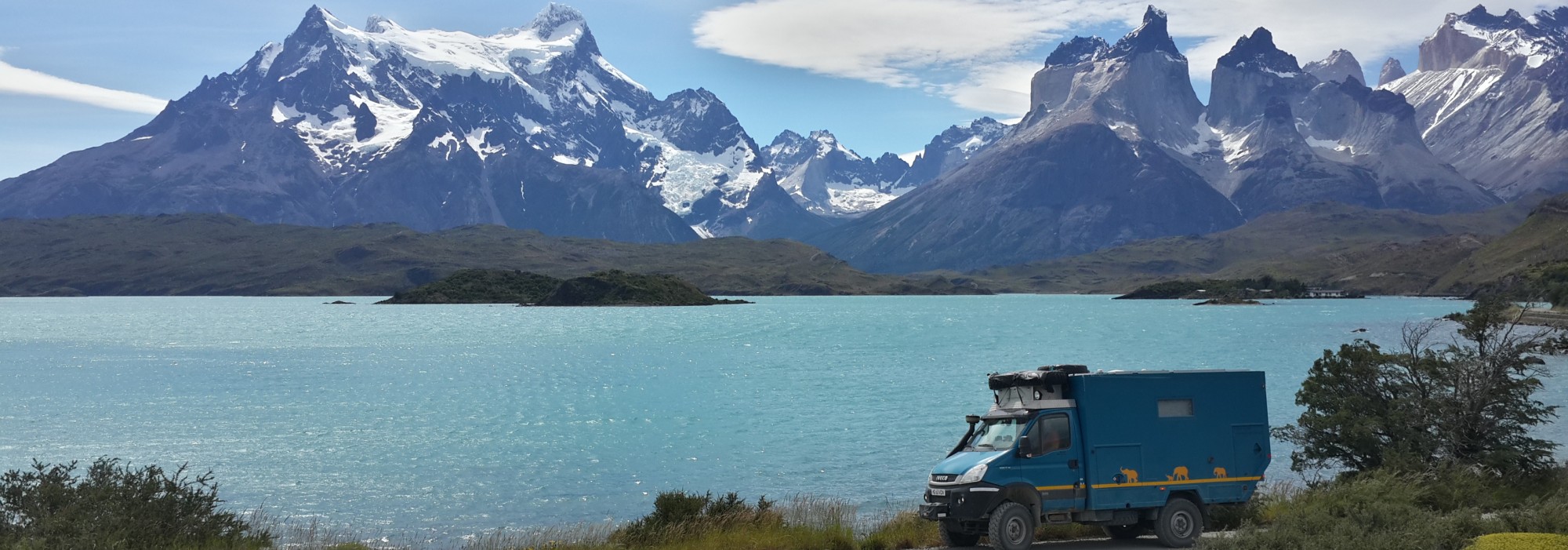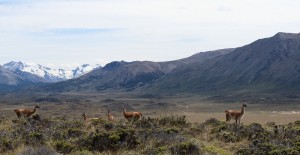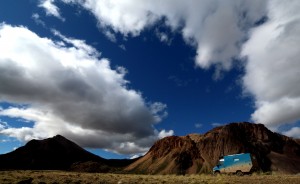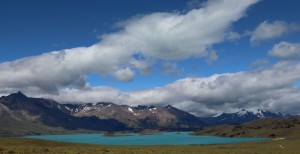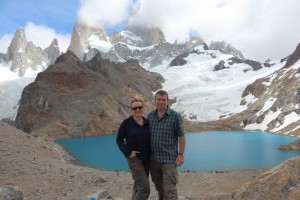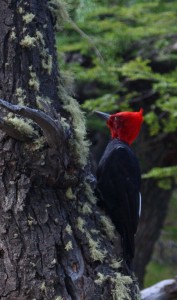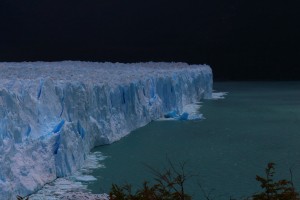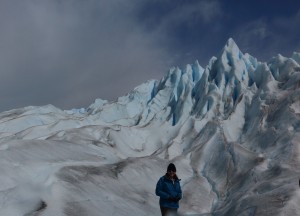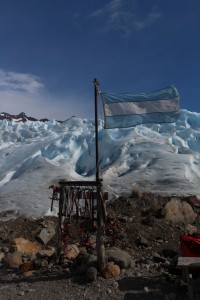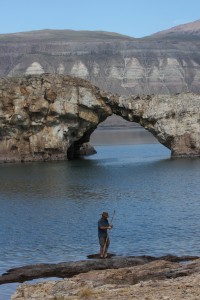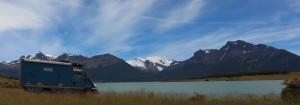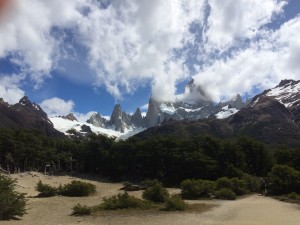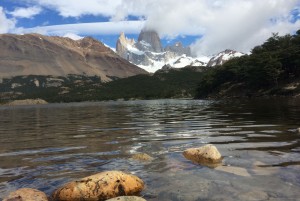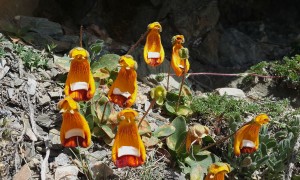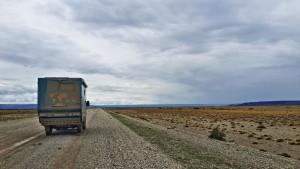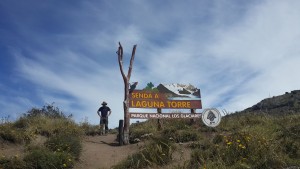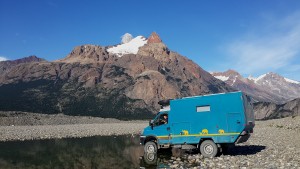 Inconveniently for us, the sights to be seen as we head north up the Andes sit alternately either side of the Argentine/Chile border, requiring more frequent border crossings than we would normally care to tackle. From Torres del Paine in Chile we now need to cross back into Argentina, first destination: the Perito Moreno Glacier and it’s gateway town of El Calafate. This glacier is another of South America’s most visited tourist attractions and the border crossing is therefore choked with coach-loads of tourists. We get caught in a frustratingly long queue, but finally we’re in… back into Argieland.
Inconveniently for us, the sights to be seen as we head north up the Andes sit alternately either side of the Argentine/Chile border, requiring more frequent border crossings than we would normally care to tackle. From Torres del Paine in Chile we now need to cross back into Argentina, first destination: the Perito Moreno Glacier and it’s gateway town of El Calafate. This glacier is another of South America’s most visited tourist attractions and the border crossing is therefore choked with coach-loads of tourists. We get caught in a frustratingly long queue, but finally we’re in… back into Argieland.
Ice-hike Perito Moreno
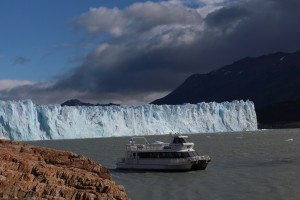
Perito Moreno’s first namesake
Just over 100 kms north of the border crossing, El Calafate turns out to be our most touristy destination yet: streets crammed with souvenir ‘tat-shops’ (admittedly some of it is quite tasteful tat, but nevertheless, ‘tat’ is ‘tat’! 🙂 ). It’s not an unpleasant town but there is no history or culture here; it has been created in the last 30 years purely to serve the tourist industry of the Southern Patagonian Icefields. All the ‘locals’ living here have been imported from Buenos Aires or other parts of urban Argentina to serve the tourist influx – to which we are now adding our patronage.
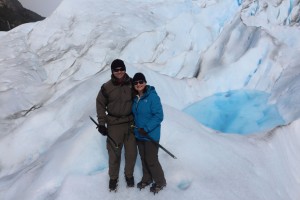 Perito Francisco Moreno is a significant figure in Argentine history: a pioneer of exploration and research into the South Patagonian Icefields in the early 20th Century. It is a little known fact of local history that his parents named him after a glacier, a national park and a town in central Argentina (or was it the other way round? 🙂 ).
Perito Francisco Moreno is a significant figure in Argentine history: a pioneer of exploration and research into the South Patagonian Icefields in the early 20th Century. It is a little known fact of local history that his parents named him after a glacier, a national park and a town in central Argentina (or was it the other way round? 🙂 ).
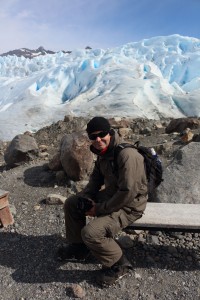
Crampons on… Bring on the ice!
The Perito Moreno Glacier is the most accessible of the many glaciers in the South Patagonian Icefield. It is unusual amongst glaciers, sitting at an extremely low altitude and is one of the very few glaciers that isn’t receding. Incredibly it can shift up to 2 meters per day as it slides from the mountains into Lake Argentina. Regular Cuthbert fans who read our Antarctica Blog a few weeks ago will know that we are rather fascinated by the whole ice business. In Calafate we visited the Glaciarum museum which explains all the science-stuff about ice/glaciers very well, but it’s remote from the ice itself. So how does one get to be on first-name terms, ‘up-close and personal’ with a glacier? Aha! Here we go… an advert for guided ice-hikes on the glacier. That’ll do the job 🙂
Joining a group at the wharf-side in the National Park, we took a short boat ride across the lake to the edge of the glacier. Here our guide Vicente issued the gear to us and after a basic briefing on the techniques, led us up the side of the glacier and onto the top. The surface of the glacier was surprisingly hilly and our crampons really had to do their stuff as we hiked up and down the icy-slopes. It was a fascinating walk, jumping over crevices, peering into ice caves and looking down into deep, deep ice-pools of crystal clear, turquoise blue water.
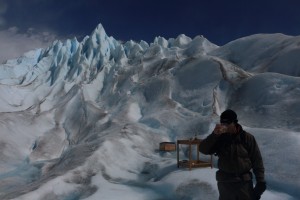
A whiskey at the Glacier Bar
Towards the end of the hike we were rather chuffed to find a small whiskey bar set-up in a sheltered cove on the ice. The ice-hike fee apparently included the opportunity to sample a ‘wee dram’ splashed over some 200 year old ice that they just hacked out of the glacier in front of us. Neither of us is normally partial to the whiskey-thing, but drinking a whiskey-shot over the ancient ice, in the sunshine and the open air of a glacier top in the Andes, was actually rather special.
The final treat as we waited by the shore for the boat to pick us up was watching enormous chunks of glacier split away and fall off into the water. The ice fell into the lake with a deep rumble, creating huge splashes and large ripples of waves across the whole lake. As the break-away chunks formed small icebergs in the lake, the crashing noise from the ice-fall continued to echo around the valleys. An amazing experience.
Stop Press… Economic Update
Remember way back at the end of 2015 when we explained about the ‘Blue Dollar’ currency problem in Argentina? We’re sure you have been scouring the press for update news on this. Well search no more… the good news is that newly elected President Macri has done ‘something’ even more quickly than the pundits expected ‘something’. Whatever it is that he did, we like it. On this return visit to Argentina, we can now (legally) exchange currency at a good value rate without the aid of the dodgey ‘cambio cambio’ men, we can use cash-points at banks and we can pay for items with credit/debit cards without fear of rip-off rates being applied. Hurrah for Mr Macri!!
Fitzroy Hikes
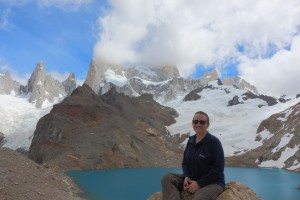
Bit pink-faced after the climb to Lago de Los Tres
Now we’re back in Cuthbert and hitting the road again, heading some 200km north to El Chaltén – another purpose-built destination for the tourists attracted to ‘The Hiking Capital of Argentina’. Gosh… more hiking! It’s a while since we did this much exercise!
The main attraction here is Mount Fitzroy and a nine hour round-trip hike to a stunning mountain lagoon ‘Lago de Los Tres’. The trail starts off climbing moderately for around 4km, followed by an easy-going flat-stage of around 5km and then… Wham! … suddenly we’re hit by a phenomenally steep section, climbing up more than 400m in a distance of around 1km, scrambling over rocks and slip-sliding in loose shingle. At the top, the reward: eating our packed-lunch with views over an azure-blue lake to some majestic granite mountain spires behind, with condors soaring in circles around us. This is what it’s all about J. Now… just the small matter of the knee-aching descent back to Cuthbert before we can relax in the evening sunshine with some fellow Brit hikers over a well-earned cold beer!
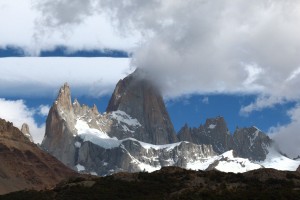
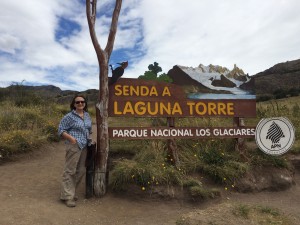 Next day, our legs are suffering slightly from yesterday’s exertion and need of a bit of ‘R&R’, so we take to Cuthbert for a scenic tootle around the area. Some 40ish km beyond El Chaltén at the end of the dirt road is Lago Desierto – a lake stretching towards the Chilean border and to a trail which takes hikers, mountain-bikers and horse riders over the Andes to Villa O’Higgins in Chile. Unfortunately, the trail beyond the lake is not ‘Cuthbert friendly’ (or friendly to any 4 wheeled vehicle for that matter) and we will have to take a much more circuitous route to Chile over the next couple of weeks. Today however, we can follow the track as far as the shore of Lago Desierto, taking us over a series of small bridges conveniently rated at 6 tons… spot-on for Cuthbert’s 5.9 ton all-up-weight 🙂 . It’s a beautiful drive and we find a pretty spot by the river to park-up for the night before re-tracing our steps back to El Chaltén for, guess what?… more hiking!
Next day, our legs are suffering slightly from yesterday’s exertion and need of a bit of ‘R&R’, so we take to Cuthbert for a scenic tootle around the area. Some 40ish km beyond El Chaltén at the end of the dirt road is Lago Desierto – a lake stretching towards the Chilean border and to a trail which takes hikers, mountain-bikers and horse riders over the Andes to Villa O’Higgins in Chile. Unfortunately, the trail beyond the lake is not ‘Cuthbert friendly’ (or friendly to any 4 wheeled vehicle for that matter) and we will have to take a much more circuitous route to Chile over the next couple of weeks. Today however, we can follow the track as far as the shore of Lago Desierto, taking us over a series of small bridges conveniently rated at 6 tons… spot-on for Cuthbert’s 5.9 ton all-up-weight 🙂 . It’s a beautiful drive and we find a pretty spot by the river to park-up for the night before re-tracing our steps back to El Chaltén for, guess what?… more hiking!
Mud Route 40
Route, or Ruta 40 is to Argentina what Route 66 is to the USA: an iconic, long and scenic drive stretching the country. Ruta 40 runs north/south down western Patagonia following the eastern edge of the Andes and is famous for vistas of high snow-capped mountains on one side, and vast open pampas plains on the other. You can’t really say that you have ‘driven Argentina’ until you have covered at least a decent section of Ruta 40 – so we pick it up as we leave El Chaltén and head north.
Ruta 40 is now mostly tarmac, but a few of the more remote sections are still rough. We start initially on tar, then just north of Tres Lagos the surface turns to dirt. We deflate Cuthbert’s tyres and blast down the rough road, riding all the bumps with ease and overtaking the sedan cars that had overtaken us back on the tar section 🙂
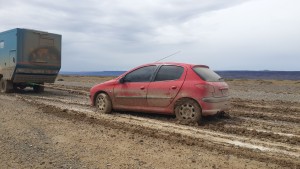 Soon it starts to drizzle and the dirt surface rapidly takes on the characteristics of a squelchy skid-pan. Rather than trundling comfortably through the countryside, Cuthbert starts to glide sideways in a graceful but random fashion down the track. The mud isn’t unduly deep, but it is of the exceptionally ‘skiddy’ variety. Marcus reduces the speed and engages the centre diff-lock as the mud becomes thicker and heavier. ‘Super-Cuthbert’ is managing without too much problem on the flat, but we soon come across a bunch of cars stuck in the mud, unable to climb a gradual but long ascent over a hill. We approach the incline, but even with Cuthbert’s top-notch 4×4 capabilities we can only just maintain the up-hill momentum. If we stop, we will almost certainly not get going again. The passengers from the various stuck cars are out in the mud, trying to push their revving cars up the hill. They stare enviously at us as we pass them and one of them waves a tow-rope at us, as if asking us to tow them. We feel bad not stopping, but we are struggling under our own weight without the drag of another car on-tow; Cuthbert is sliding into a sideways, barely controllable, crab-like climb as we negotiate the hill past them. We try not to laugh (honestly 🙂 ) but they are a slightly comical sight, standing up to their ankles in mud, pushing on the boot-lids and being sprayed with yet more mud from the back wheels of their cars as the engines are revved in vain. Ultimately however, there were many cars together, no-one was stranded alone and many of them could have turned around to return to the tarmac road (albeit with a significantly longer detour to reach their destination).
Soon it starts to drizzle and the dirt surface rapidly takes on the characteristics of a squelchy skid-pan. Rather than trundling comfortably through the countryside, Cuthbert starts to glide sideways in a graceful but random fashion down the track. The mud isn’t unduly deep, but it is of the exceptionally ‘skiddy’ variety. Marcus reduces the speed and engages the centre diff-lock as the mud becomes thicker and heavier. ‘Super-Cuthbert’ is managing without too much problem on the flat, but we soon come across a bunch of cars stuck in the mud, unable to climb a gradual but long ascent over a hill. We approach the incline, but even with Cuthbert’s top-notch 4×4 capabilities we can only just maintain the up-hill momentum. If we stop, we will almost certainly not get going again. The passengers from the various stuck cars are out in the mud, trying to push their revving cars up the hill. They stare enviously at us as we pass them and one of them waves a tow-rope at us, as if asking us to tow them. We feel bad not stopping, but we are struggling under our own weight without the drag of another car on-tow; Cuthbert is sliding into a sideways, barely controllable, crab-like climb as we negotiate the hill past them. We try not to laugh (honestly 🙂 ) but they are a slightly comical sight, standing up to their ankles in mud, pushing on the boot-lids and being sprayed with yet more mud from the back wheels of their cars as the engines are revved in vain. Ultimately however, there were many cars together, no-one was stranded alone and many of them could have turned around to return to the tarmac road (albeit with a significantly longer detour to reach their destination).
Had there been just one or two cars stuck in the mud and potentially stranded in a remote location we would not have hesitated to stop and help as best we could, and this turned out to be the case some 30 miles further along the mud-swamp. We stopped to help a 4×4 driver coming in the opposite direction who was struggling to turn around to return to the firm road. Soon after that, we found a small Peugeot car with two very friendly Argentinian couples on holiday from Bahia Blanca. They had slid off the road on a flat section and the four of them had been struggling for around half an hour to free their car. We stopped, donned our Rwandan wellies (remember, those of the first use in Tierra del Fuego a few weeks ago?) and jumped into the squelchy mud to hook the stuck car up to (a very muddy) Cuthbert. First the passengers had to walk down the road until the car was out of the deeper-dwang, then we towed them all in the car to a firmer section of the track, and finally we followed closely behind them some 25km to see them to the tarmac road. They were all very friendly and grateful people and we were pleased to be able to help them. Sadly it would be an extremely long detour for us to divert to Bahia Blanca and take up their kind invitation to dinner in their home.
Another Perito Moreno
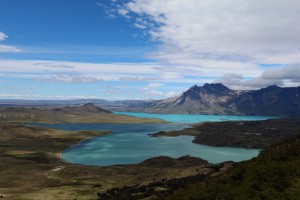
No photo-shopping-colour added, it really was this blue!
After our great day ice-hiking on the Perito Moreno Glacier last week, we are now over 300km further north and heading to the Perito Moreno National Park. This park is not as well-known and is much less visited than the other mass-tourism parks that we have visited recently; it receives only around 1,200 visitors a year. Nevertheless, it is highly recommended by our guide-book and by other overlanding travellers. “So…” one might reasonably ask… “if it’s that good, why is it so little visited?” Well, for a start the park is remote. It’s 100km down a single track dirt road from the Ruta 40 and over 200km from the nearest small town. It isn’t served by any public transport. Getting to see gems like this is what overlanding in your own self-sufficient 4×4 campervan is all about: the opportunity to visit some of the amazing corners of countries that ‘ordinary’ tourists don’t find the time to see.
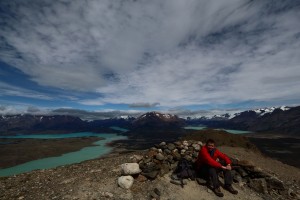 So how was it? Well… the combination of jaw-dropping scenery, wild-life and the desolate remoteness of this place makes it one of the highlights of our trip so far. Yes, the mountain scenery of Torres del Paine and Fitzroy were amazing, but they were always shared with hoardes of other tourists. Piccadilly Circus has got nothing on the crowds at some of those mountain rest-stops 🙂 . Perito Moreno Park is very different: wild and almost untouched by tourism. Facilities are minimal. It’s peak season now and in our whole time in the park we saw only three other vehicles! The scenery is infinitely photogenic. Vast, open golden-green plains dotted with herds of roaming guanaco and rheas, mountains with multi-coloured rock layers glowing in the sunshine, bird-lakes populated with upland geese, black-neck swans and pink flamingos. And the ‘piece de resistance’: exquisite aquamarine glacier lakes that seem to have somehow been photo-shopped into the view. No photo-shopping-colour-enhancing here – the colours you see in the pics are exactly what you get here. Splendid! Don’t miss this park if you happen to be passing down Ruta 40 anytime 🙂 !
So how was it? Well… the combination of jaw-dropping scenery, wild-life and the desolate remoteness of this place makes it one of the highlights of our trip so far. Yes, the mountain scenery of Torres del Paine and Fitzroy were amazing, but they were always shared with hoardes of other tourists. Piccadilly Circus has got nothing on the crowds at some of those mountain rest-stops 🙂 . Perito Moreno Park is very different: wild and almost untouched by tourism. Facilities are minimal. It’s peak season now and in our whole time in the park we saw only three other vehicles! The scenery is infinitely photogenic. Vast, open golden-green plains dotted with herds of roaming guanaco and rheas, mountains with multi-coloured rock layers glowing in the sunshine, bird-lakes populated with upland geese, black-neck swans and pink flamingos. And the ‘piece de resistance’: exquisite aquamarine glacier lakes that seem to have somehow been photo-shopped into the view. No photo-shopping-colour-enhancing here – the colours you see in the pics are exactly what you get here. Splendid! Don’t miss this park if you happen to be passing down Ruta 40 anytime 🙂 !
Handy Caves, New Shoes and a Trout
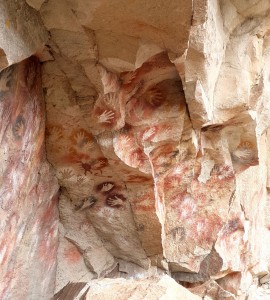
Unimaginative but handy motif 🙂
Leaving the marvellous Perito Moreno Park behind, we head off now on our last leg before re-crossing the border (again!) into Chile. On our way north, we stop off at ‘Cueva de Las Manos’ (Cave of the Hands) to see some ancient hand-imprint rock painting; cliff-faces covered in a continuous painted-motif of left hands. The design arrangement is not dissimilar to a that produced by a class of 5 year olds on art-day, but as these paintings are between 3,000 and 8,000 years old, we’ll cut them some slack with the deficit of artistic flair 🙂 (and to be fair, we couldn’t do much better ourselves!). However unoriginal the motif might be, the paintings are astonishingly bright and clear for their age and the setting in the Río Pinturas canyon adds to the beauty.
Our final night stop, or what was meant to be our final night stop, in Argentina before crossing to Chile, was on the shore of Lake Posada. But when we got there, it turned out to be far too nice to stay for just one night. A remote and very beautiful spot on the lakeside overlooking an unusual island-arch of rock. The weather was spectacularly good so we decided to stay put for a while and, as we believe the kids are saying these days, ‘chill-out’ 🙂
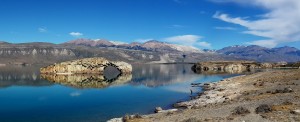
Nice day at the stone arch, Lago Posada
During our ‘chilling out’ at this quiet lake-shore we decided that the time had now come to fit Cuthbert with new shoes (the Michelin XZLs that we bought back in Hamburg before boarding the boat to Montevideo). We have schlepped these new tyres over 9,000 km around South America and the time has come to say farewell to Cuthbert’s current tyres which have seen him good since northern South Africa last year. Apparently there are people out there who are interested in the process of changing large, off-road, tubeless, truck tyres on split-rim wheels. If you happen to be one such person, then you may wish to click here to see the video of Cuthbert’s tyre change. Alternatively, you may just have a life to get on with 🙂 .
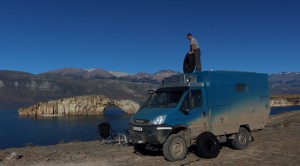
Cuthbert getting new shoes
Another event during our ‘chilling’ time was a convoy of Brazilian over-landing vehicles descending on our peaceful spot. They arrived at 09:30 am one day and our hearts sank as they parked up right alongside us. They were friendly and very noisy (bang goes our peaceful lake-day) but it is always nice to meet other travellers. We got talking to the group and… bear with us here… we’re now taking a quick wander back to our recent Blog Post about the Mylodon cave near Puerto Natales… remember that little vignette about the giant prehistoric ground sloth? Well… this group of Brazilian overlanders were called the Rio de Janeiro Mylodon Group (now do you see the link?) and taught us a further interesting fact about said extinct critter. The Mylodon was apparently the only pre-historic animal to have wandered huge distances throughout the whole continent of South America. The Brazilian tour leader explained that because most of his co-travellers were almost old enough to be pre-historic and because they planned to travel to every country on the continent, they chose the Mylodon name for their group. Anyway, our fears for the destruction of our peaceful day proved to be unfounded; they didn’t stay long. Hmmm… we did shower last night… so it must have been something we said 🙂
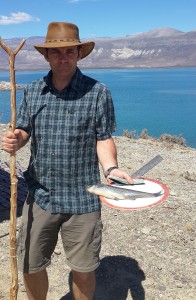
Enough for a trouty snack
When we first set off travelling in Cuthbert, we had slightly idyllic notions of parking up by lakes, catching and fileting our own fish for supper. We purchased a ridiculously expensive professional chef’s fileting knife, certain that it would see much service during our life on the road. Now, two years down the road, we have camped on many shores in Africa and in South America, but not once bothered to cast a fishing line… until today. Today, in Lake Posada Argentina, we decide to give it a try. Marcus set out the line and within a couple of hours… very exciting… we had a bite! Not the biggest trout you’ve ever seen, but enough for a tasty snack. Out came the expensive fileting knife for its first trial, but without glowing results. Let’s just say our fileting skills still need a little honing. Oh well, practice makes perfect! Anyway, we fried the hacked-off chunks of trout in some butter within half an hour of it coming out of the lake. That’s about as fresh as it gets, huh? Not pretty, but really delicious.
Finally, after a few chilled-out days by Lago Posada, we leave Argentina for the time being and head over the Paso Roballo border into Chile. We like Argentina very much, particularly since Mr Macri sorted out that troublesome ‘Blue Dollar’ business. We’ll be back again when we get a bit further north… Bye for now.
Link to next blog: The Carretera Austral Link to full South America Blog
